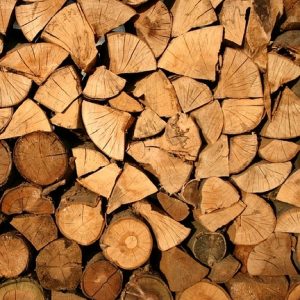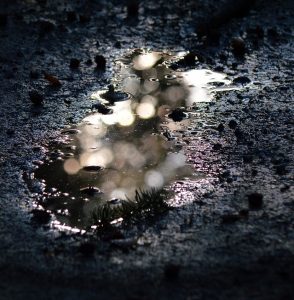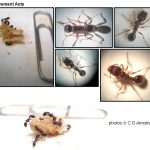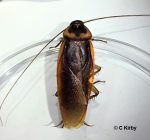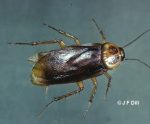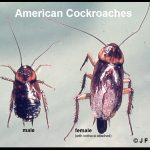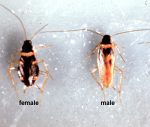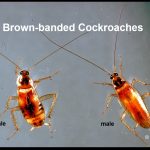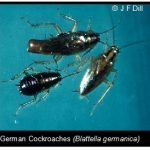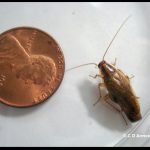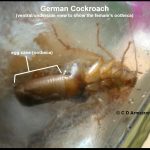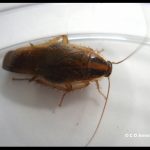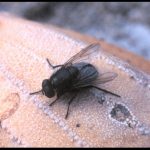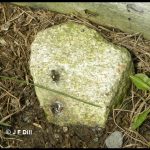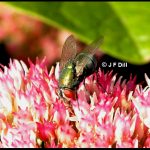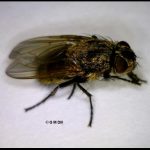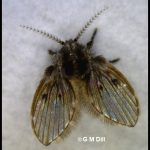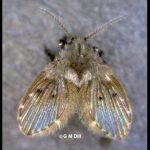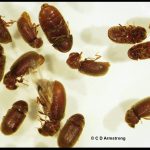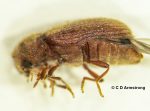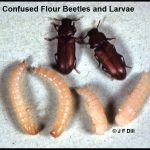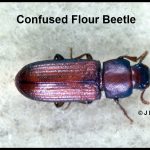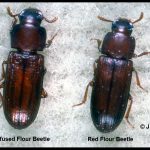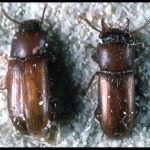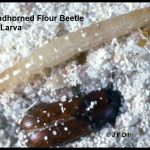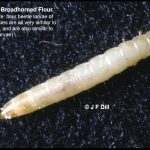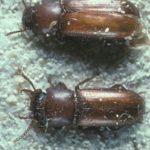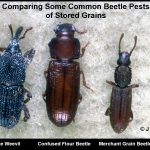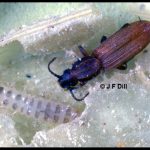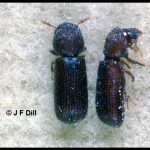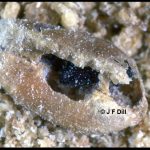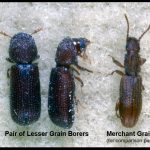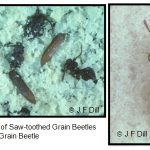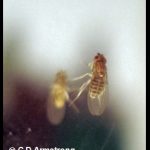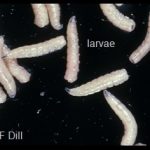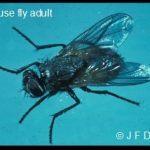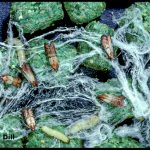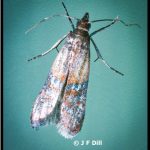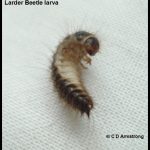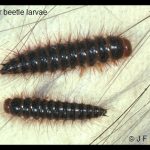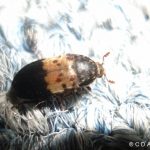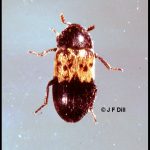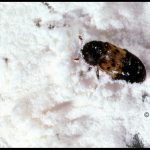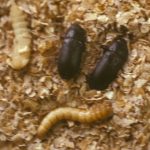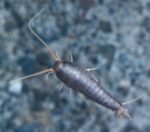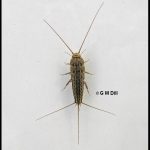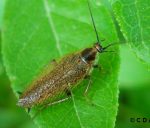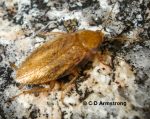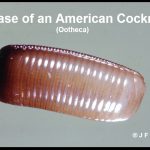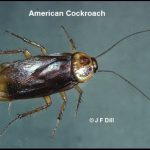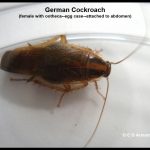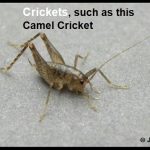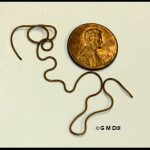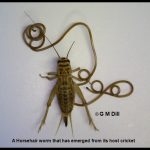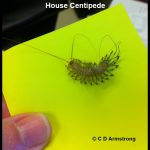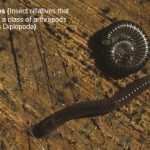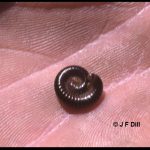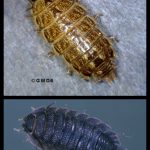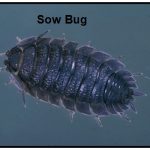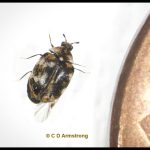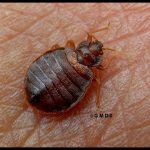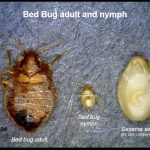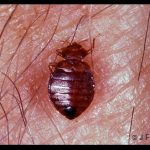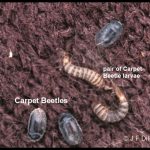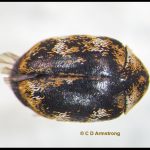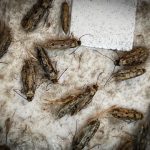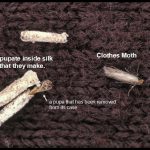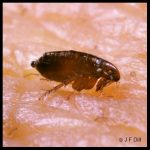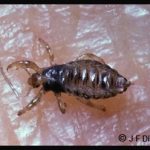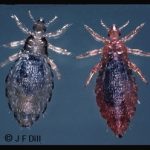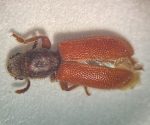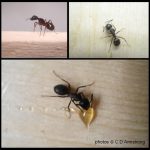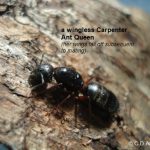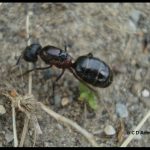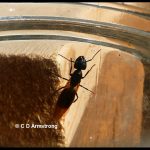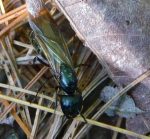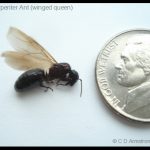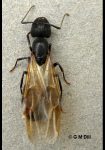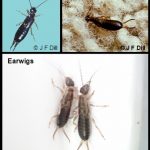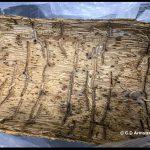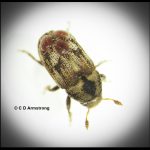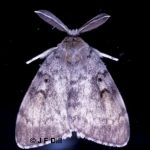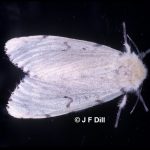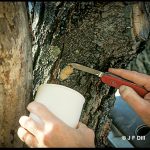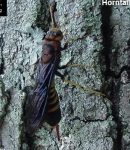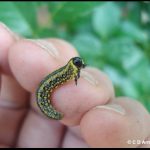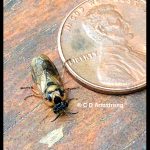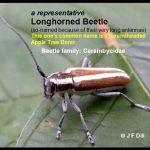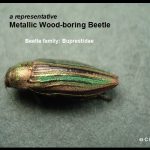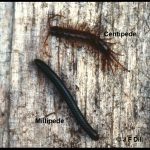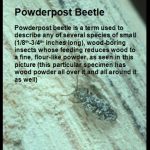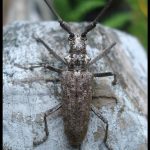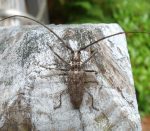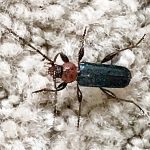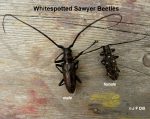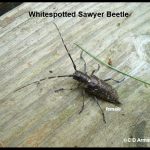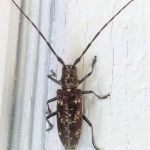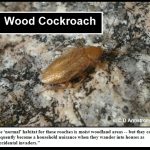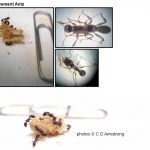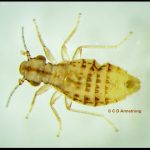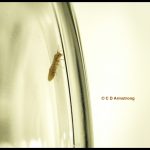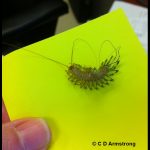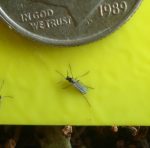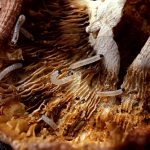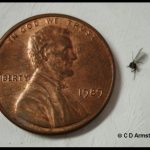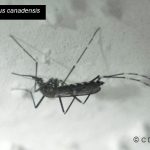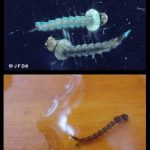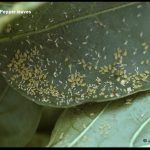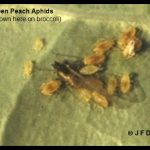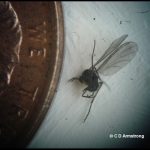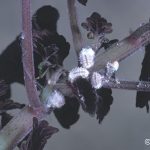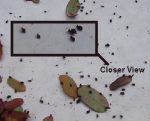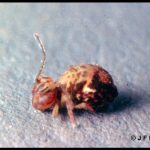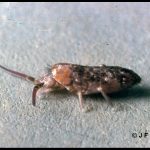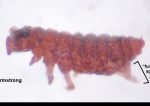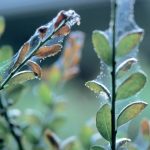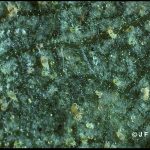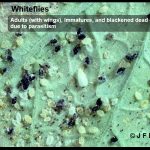Insect ID: Indoors (in a house, greenhouse, garage, shed, etc.)
Return to Insect ID: Habitat
Kitchen and Food Storage Areas:
- Ants (especially Pavement Ants which are pictured here)
- American Cockroach (female)
- American Cockroach (female)
-
American Cockroaches
(Male versus Female)
- Brown-banded Cockroaches
- Brown-banded Cockroaches (female: left; male: right)
- German Cockroaches
- German cockroach (female) (Blattella germanica)
- Ventral view of a female German cockroach, revealing her egg case called an ootheca
- Female German cockroach with ootheca (egg case) attached to her abdomen
- Blow Fly
- Blow Fly
- A type of blow fly commonly called a Green Bottle Fly.
- Cluster Fly
- Drain Fly (also called a Moth Fly)
- Drain Fly (additional example)
- Drugstore Beetles (Stegobium paniceum) (Alton, Maine; 8/2/2021)
- Drugstore Beetle (Stegobium paniceum) (Alton, Maine; 8/2/2021)
- Confused Flour Beetles and larvae
- Confused Flour beetle
- Flour Beetles (Left: Confused Flour Beetle; Right: Red Flour Beetle)
- Broadhorned Flour beetles
- A Broad-horned Flour Beetle and a larva of the same species
- Larva of a Broad-horned Flour Beetle
- Flour Beetles
- Comparison of three different beetle pests of stored grains
- Grain beetle (adult and larva/grub)
- Lesser Grain Borers
- Lesser Grain Borer damage to a grain of millet
- Lesser Grain Borers and a Merchant Grain Beetle
- Grain Beetles
- House Fly larvae
- House Fly
- Pantry Moths / Flour Moths (Plodia interpunctella) (plus larvae and the webbing that the larvae spin, shown with one of their more unusual food sources: rodenticide pellets)
- Pantry Moth / Flour Moth (Plodia interpunctella)
- Larder Beetle larva
- Larder Beetle larvae
- Larder Beetle (Dermestes lardarius)
- Larder Beetle (Dermestes lardarius)
- Larder Beetle (Dermestes lardarius)
-
Mealworms
(larvae and adults)
- Silverfish
- Four-lined Silverfish (Ctenolepisma lineatum)
- Example of a wood roach (Dusky Cockroach, Ectobius lapponicus) (male) (Stetson, Maine; 7/13/2015)
- Example of a wood roach (Tawny Cockroach, Ectobius pallidus) (male) (Acadia National Park, Maine; 10/11/2009)
Kitchen and Food Storage Areas:
- Ants (especially Pavement Ants)
- Blow Flies
- Broadhorned Flour Beetle
- Cluster Flies
- Cockroaches
- American Cockroach
- Brown-banded Cockroach
- German Cockroach
- Wood roaches (they only live outdoors but are attracted to lights at night so sometimes find their way indoors accidentally; visit our Cockroaches page for more information about them)
- Drugstore Beetles (Univ. of Florida) | See also Drugstore Beetle (BugGuide.net) and Drugstore Beetles (Univ. of Wisconsin)
- Flour Beetles
- Flour Moth
- Four-lined Silverfish
- Fruit Flies
- Grain Beetles
- Grain / Flour Mites (University of Kentucky)
- House Flies
- Indian Meal Moth
- Larder Beetles
- Lesser Grain Borers
- Lesser Mealworms
- Mealworms
- Pantry Moth
- Pavement Ants
- Sawtoothed Grain Beetles
- Silverfish
Sink, Tub, Pet Dish, Toilet, etc:
- American Cockroach (female)
-
American Cockroaches
(Male versus Female)
- Egg Case (Ootheca) from an American Cockroach
- American Cockroach
- Brown-banded Cockroaches
- Brown-banded Cockroaches (female: left; male: right)
- female German cockroach with ootheca egg case attached to abdomen
- Ventral view of a female German cockroach, revealing her egg case called an ootheca
- German Cockroaches
- German Cockroach
- Crickets (such as the Camel Cricket shown here)
- Drain Fly (also called a Moth Fly)
- Drain Fly (additional example)
- Four-lined Silverfish (Ctenolepisma lineatum)
- Horsehair Worm (these are not insects, of course)
- A Horsehair worm that has emerged from its host cricket
- Horsehair worm inside a 3.5″ diameter petri dish
- House Centipede
- House Fly
- House Fly larvae
- Mealworms (larvae and adults) (Found in areas with dry dog or cat food)
-
Millipedes
(considered an ‘Occasional Household Invader’)
- Millipede
- Larder Beetle larva
- Larder Beetle larvae
- Larder Beetle (Dermestes lardarius)
- Sowbugs
- Sow Bug
- Varied Carpet Beetle (Anthrenus verbasci) next to a U.S. penny for scale purposes (specimen from Orono, ME; 5/3/2023)
- Example of a wood roach (Dusky Cockroach, Ectobius lapponicus) (male) (Stetson, Maine; 7/13/2015)
- Example of a wood roach (Tawny Cockroach, Ectobius pallidus) (male) (Acadia National Park, Maine; 10/11/2009)
Sink, Tub, Pet Dish, Toilet, etc:
- Carpet Beetles
- Cockroaches
- American Cockroach
- Brown-banded Cockroach
- German Cockroach
- Wood roaches (they only live outdoors but are attracted to lights at night so sometimes find their way indoors accidentally; visit our Cockroaches page for more information about them)
- Crickets (most often in basements and garages)
- Drain Flies (also called Moth Flies) (around sewage or other wet areas)
- Four-lined Silverfish
- Horsehair Worm
- House Centipede
- House Flies
- Larder Beetles
- Mealworms
- Millipedes
- Silverfish
- Sowbugs (Univ. of Maryland / UMD Cooperative Extension)
Carpet / Clothing / Fabric:
- Bed Bug (adult female)
- Size Comparisons: Adult Bed Bug (Left), Bed Bug Nymph (Middle), and Sesame Seed (Right)
- (additional example) Bed Bug (adult)
- Carpet Beetles and Carpet Beetle larvae
- Larder Beetle larva
- Larder Beetle larvae
- Larder Beetle (Dermestes lardarius)
- Larder Beetle (Dermestes lardarius)
- Varied Carpet Beetle (Anthrenus verbasci) next to a U.S. penny for scale purposes (specimen from Orono, ME; 5/3/2023)
- Varied Carpet Beetle (Anthrenus verbasci) (magnified view; playing dead as they are apt to do)
- Brown-dotted Clothes Moths / European House Moths (Niditinea fuscella) (they do not feed on clothing or fabrics; captured on a pheromone trap intended for fabric-damaging clothes moths; Peaks Island, ME; 6/28/2024) (Photo courtesy of Jean Hoffman)
- Case-bearing Clothes Moth (Tinea pellionella)
- Fleas (Cat Flea shown here)
- Mites ( Dust Mites) (Parasitic Mites of Humans)
Carpet / Clothing / Fabric:
- Bed Bugs
- Carpet Beetles (including Larder Beetles)
- Clothes Moths
- Fleas
- Non-insect Possibilities:
- Mites
- Bird Mites [will bite people in the absence of their bird host(s)] (University of Minnesota Extension)
- Dust Mites
- Mold Mites / Tyroglyphid Mites (Iowa State University)
- Grain / Flour Mites (University of Kentucky)
- Parasitic Mites of Humans (University of Kentucky)
- Mites
Mattress / Sofa / Recliner (etc.):
- Bed Bug (adult female)
- Size Comparisons: Adult Bed Bug (Left), Bed Bug Nymph (Middle), and Sesame Seed (Right)
- (additional example) Bed Bug (adult)
- Fleas (Cat Flea shown here)
- Head Louse
- Head Lice
- Masked Hunter (A type of Assassin Bug)
- Varied Carpet Beetle (Anthrenus verbasci) next to a U.S. penny for scale purposes (specimen from Orono, ME; 5/3/2023)
Mattress / Sofa / Furniture:
- Bed Bugs
- Carpet Beetles (sometimes mistaken for ticks due to their small size)
- Fleas
- Head Lice
- Masked Hunter
- Non-insect Possibilities: Mites (not pictured)
- Bird Mites [will bite people in the absence of their bird host(s)] (University of Minnesota Extension)
- Dust Mites
- Parasitic Mites of Humans (University of Kentucky)
Firewood (On or Near):
See also the Maine Forest Service’s Insects From Firewood publication, and please remember: Don’t transport firewood!
- Blood-Colored Checkered Beetle (Zenodosus sanguineus) (These beetles are predators of woodboring insects) (Bridgton, ME; 10/20/2023) (Photo courtesy of Rebecca Long, UMaine Extension)
- Carpenter Ants (workers) (one of the workers is feeding on a drop of honey)
- Queen Carpenter Ant (wingless stage)
- Carpenter Ant Queen (wingless stage; they shed their wings after mating)
- Carpenter Ant (Winged Queen)
- Carpenter Ant (Winged Queen)
- Carpenter Ant (Winged Queen)
- Carpenter Ant (Winged Queen)
- Crickets (such as the Camel Cricket shown here)
- Earwigs
- Interior portion of ash bark showing the tunneling and brood chambers carved out by Eastern Ash Bark beetles (The egg galleries run perpendicular to the tree’s branch and/or trunk) (Easton, ME; 3/10/2022)
- Eastern Ash Bark Beetle (Hylesinus aculeatus) (July 21st, 2021; from firewood in Pittsfield, Maine) (with three phoretic mites hitching a ride on its back)
- Spongy Moth (Lymantria dispar) (male)
- Spongy Moth (female)
- Removing a Spongy Moth egg mass
- Species of Horntail (also called Wood Wasps) (this one is the Pigeon Horntail, Tremex columba)
- House Centipede
- Introduced Pine Sawfly larva (July 11, 2015) (central Maine)
- Introduced Pine Sawfly adult (Etna, ME; 4/15/2020)
- Example of a Longhorned Beetle (so-named because of their very long antennae; this one shown here is a Roundheaded Apple Tree Borer)
- Metallic Wood-boring Beetle (Family: Buprestidae)
- Centipedes and Millipedes
-
Millipedes
(considered an ‘Occasional Household Invader’)
- Millipede
- Powderpost Beetle
- Sowbugs
- Sow Bug
- Northeastern Pine Sawyer (closer view)
- Northeastern Pine Sawyer
- Tanbark Borer / Violet Tanbark Beetle (Phymatodes testaceus) (Cape Elizabeth, ME; 5/4/2023) (Photo courtesy of MB)
- Whitespotted Sawyer Beetles
- Whitespotted Sawyer beetle (female)
- Whitespotted Sawyer Beetle (female); Photo by C. Armstrong
- A male Ectobius cockroach (likely a Tawny Cockroach, Ectobius pallidus) seen in Acadia National Park; Oct. 11th, 2009.
Firewood (On or Near):
- Bark Beetles
- Blood-colored Checkered Beetle (predators of woodboring insects) (BugGuide.net)
- Carpenter Ants
- Crickets
- Earwigs
- Eastern Ash Bark Beetles
- G**** Moth — find it now by its new name of Spongy Moth
- Horntails
- House Centipede
- House Crickets (most often in basements)
- Introduced Pine Sawfly
- Longhorned Beetles (and Roundheaded Borers) (Iowa State Univ.)
- Metallic Wood-Boring Beetles (Univ. of Minnesota Extension)
- Millipedes
- Pennsylvania Wood Roach
- Powderpost Beetles
- Sawyer Beetles
- Sowbugs (Univ. of Maryland / UMD Cooperative Extension)
- Spongy Moth
- Tanbark Borer / Violet Tanbark Beetle (often encountered when they emerge indoors from oak firewood) (BugGuide.net)
- Wood Roach
See also: Nuisance Wood Borers and Seed Insects in Homes (Univ. of Minnesota)
Wet or Damp Areas (including wet and rotting wood, damp books, etc):
- Blow Fly
- A species of booklice (possibly Trogium pulsatorium)
- A species of booklice resting at the edge of a glass petri dish (closer view of the same specimen is shown in the adjacent image at right)
- Carpenter Ants (workers) (one of the workers is feeding on a drop of honey)
- Centipedes and Millipedes
- House Centipede
-
Millipedes
(considered an ‘Occasional Household Invader’)
- Millipede
- Crickets (such as the Camel Cricket shown here)
- Drain Fly (also called a Moth Fly)
- Drain Fly (additional example)
- Earwigs
- Dark-winged Fungus Gnats (Family Sciaridae) captured on a yellow sticky card placed in the pot of a houseplant (they are drawn to light and also to the color of yellow)
- Fungus gnat larvae in a mushroom cap
- Fungus gnat
- A Horsehair worm that has emerged from its host cricket
- Horsehair Worm (these are not insects, of course)
- Mosquito (Ochlerotatus canadensis)
- Mosquito Larvae
- Silverfish
- Four-lined Silverfish (Ctenolepisma lineatum)
- Sowbugs
Wet or Damp Areas (including wet and rotting wood):
- Ants
- Booklice
- Blow Flies
- Carpenter Ants (attracted to wet/rotting wood)
- Centipedes
- Crickets
- Drain Flies (also called Moth Flies) (around sewage or other wet areas)
- Earwigs
- Four-lined Silverfish
- Fungus Gnats
- Horsehair Worm
- House Centipede
- House Crickets (most often in basements)
- Millipedes
- Mites
- Clover Mites (Penn State)
- Mold Mites / Tyroglyphid Mites (Iowa State University)
- Grain / Flour Mites (University of Kentucky)
- Mosquitoes (Maine Forest Service) see also:
- Mosquito Biology (UMaine Extension)
- Mosquito Management (UMaine Extension)
- Insect Repellents (UMaine Extension)
- West Nile Virus (CDC)
- Preventing Eastern Equine Encephalitis (EEE) Virus in Maine
- Silverfish
- Sowbugs (Univ. of Maryland / UMD Cooperative Extension)
- Wood Roach
Potted Plants / Houseplants / Greenhouses:
- Aphids on Pepper Leaves
- Green Peach Aphids on broccoli
- A species of booklice resting at the edge of a glass petri dish (closer view of the same specimen is shown in the adjacent image at right)
- A species of booklice (possibly Trogium pulsatorium)
- Dark-winged Fungus Gnats (Family Sciaridae) captured on a yellow sticky card placed in the pot of a houseplant (they are drawn to light and also to the color of yellow)
- Fungus gnat larvae in a mushroom cap
- Fungus gnat
- Fungus gnat (closer view)
- Mealybugs (Family Pseudococcidae)
- Springtails (snow fleas) collected from a cranberry bog
- Closeup of a globular springtail
- Closeup of a Springtail
- Closeup image of a Sprintail
- Spider Mites (leaves with webbing are a telltale sign)
- Two-spotted Spider Mites
- Whiteflies
Potted Plants / Houseplants / Greenhouses:
- Aphids
- Booklice
- Fungus Gnats
- Leafminers (University of Florida)
- Mealybugs (on house plants) (Univ. of New Hampshire)
- Sowbugs (Univ. of Maryland / UMD Cooperative Extension)
- Springtails
- Thrips
- Whiteflies (University of Missouri)
- Non-insect Possibilities: Spider Mites / Two-Spotted Spider Mites | Cyclamen Mites (Univ. of Kentucky)| Broad Mites (Tennessee State Univ.)





